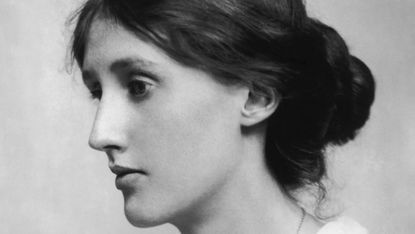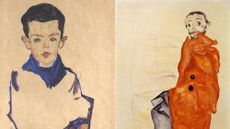Virginia Woolf: Google Doodle marks writer’s 136th birthday
Mrs Dalloway and To The Lighthouse author credited with rejuvenating the English novel

Virginia Woolf has been commemorated with a Google Doodle on what would be her 136th birthday.
Woolf’s bold and imaginative style is credited with changing English fiction, says The Independent, “pushing it beyond the tried-and-tested narrative structures of the Victorian era into fresh and experimental new territory”.
The woman who would go on to be Virginia Woolf was born Adeline Virginia Stephen in 1882 to a well-to-do London family headed by her father, author and historian Sir Leslie Stephen.
Subscribe to The Week
Escape your echo chamber. Get the facts behind the news, plus analysis from multiple perspectives.

Sign up for The Week's Free Newsletters
From our morning news briefing to a weekly Good News Newsletter, get the best of The Week delivered directly to your inbox.
From our morning news briefing to a weekly Good News Newsletter, get the best of The Week delivered directly to your inbox.
Along with her three siblings and four half-siblings, the young Woolf grew up in an intellectual milieu. She was tutored at home, but unlike her two brothers, did not attend university - an omission she would later lament as the result of prejudice against women in higher education.
The death of her mother and her beloved older half-sister while Woolf was still a teeenager provoked the first of a series of nervous breakdowns which would go on to inform her psychologically acute and emotionally nuanced work.
In 1912, she married Leonard Woolf, a former civil servant turned writer. Despite evidence of her bisexuality, the marriage was a happy one.
Both became members of the Bloomsbury Group, a network of prominent intellectuals, writers and artists centred around the titular area of London.
Other members included the economist John Maynard Keynes, biographer Lytton Strachey and Room With a View author E. M. Forster.
Over a prodigious literary career, Woolf penned a wide variety of essays, criticism and novels, the most famous of which include To The Lighthouse and Mrs Dalloway. After struggling with depression and mood swings for decades, in 1941, at the age of 51, she drowned herself in a river near her home in Lewes, East Sussex.
She is remembered for pioneering the stream-of-consciousness style, whereby thoughts and feelings are expressed on the page seemingly spontaneously, as they are in the mind. Her fiction “elevated sometimes mundane settings while examining the complex interior lives of her characters,” says CNET.
In her famous 1929 essay, A Room of One’s Own, Woolf wrote about women’s erasure from literary and historical narratives, and stressed the need for women to have literal and metaphorical space to voice their own thoughts and experiences.
The essay, with its famous observation that “'A woman must have money and a room of her own if she is to write fiction,” remains one of the foundation texts of modern feminism.
Create an account with the same email registered to your subscription to unlock access.
Sign up for Today's Best Articles in your inbox
A free daily email with the biggest news stories of the day – and the best features from TheWeek.com
-
 Is the Gaza war tearing U.S. campuses apart?
Is the Gaza war tearing U.S. campuses apart?Today's Big Question Protests at Columbia University, other institutions, pit free speech against student safety
By Joel Mathis, The Week US Published
-
 DOJ settles with Nassar victims for $138M
DOJ settles with Nassar victims for $138MSpeed Read The settlement includes 139 sexual abuse victims of the former USA Gymnastics doctor
By Justin Klawans, The Week US Published
-
 14 recent scientific breakthroughs
14 recent scientific breakthroughsIn Depth From photos of the infant universe to an energy advancement that could save the planet
By Devika Rao, The Week US Published
-
 Puffed rice and yoga: inside the collapsed tunnel where Indian workers await rescue
Puffed rice and yoga: inside the collapsed tunnel where Indian workers await rescueSpeed Read Workers trapped in collapsed tunnel are suffering from dysentery and anxiety over their rescue
By Sorcha Bradley, The Week UK Published
-
 Gaza hospital blast: What the video evidence shows about who's to blame
Gaza hospital blast: What the video evidence shows about who's to blameSpeed Read Nobody wants to take responsibility for the deadly explosion in the courtyard of Gaza's al-Ahli Hospital. Roll the tape.
By Peter Weber, The Week US Published
-
 Giraffe poo seized after woman wanted to use it to make a necklace
Giraffe poo seized after woman wanted to use it to make a necklaceTall Tales And other stories from the stranger side of life
By Chas Newkey-Burden, The Week UK Published
-
 Helicopter sound arouses crocodiles
Helicopter sound arouses crocodilesTall Tales And other stories from the stranger side of life
By Chas Newkey-Burden, The Week UK Published
-
 Woman sues Disney over 'injurious wedgie'
Woman sues Disney over 'injurious wedgie'Tall Tales And other stories from the stranger side of life
By Chas Newkey-Burden, The Week UK Published
-
 Emotional support alligator turned away from baseball stadium
Emotional support alligator turned away from baseball stadiumTall Tales And other stories from the stranger side of life
By Chas Newkey-Burden, The Week UK Published
-
 Europe's oldest shoes found in Spanish caves
Europe's oldest shoes found in Spanish cavesTall Tales And other stories from the stranger side of life
By Chas Newkey-Burden, The Week UK Published
-
 Artworks stolen by Nazis returned to heirs of cabaret performer
Artworks stolen by Nazis returned to heirs of cabaret performerIt wasn't all bad Good news stories from the past seven days
By The Week Staff Published